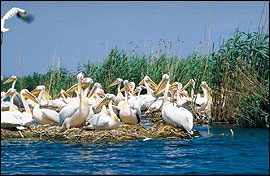Colonial water birds in the Danube Delta |
 |
The new study helps to understand how to spatially plan and design wetland restoration measures in the Danube Delta and other wetland areas elsewhere. |
During the 2001 and 2002 breeding seasons two comprehensive
surveys of colonially breeding water birds were carried out for the first time in the Romanian and Ukrainian parts of the Danube Delta. Over 210 colonies were surveyed, in which almost 40,000 pairs of 13 species were found. The most abundant species were Great Cormorant, Pygmy Cormorant and Great
White Pelican. High numbers were also found for Glossy Ibis, Black-crowned Night-heron, Little Egret and Squacco Heron. The presence in similar numbers of such a wide array of colonial water birds is unique for Europe.
The study reveals that colony sizes depend on the availability of safe nest sites for establishing a colony and the carrying capacity in terms of food availability within the a species-dependent flight range.
Understanding site selection and distribution of feeding
and breeding habitats in the Danube Delta is not only relevant for sustained conservation of its own unique wildlife, but is also fundamental in restoration
attempts for man-made river and wetland systems. Larger and heavier species need more space, while smaller and lighter ones are linked to a high degree of landscape coherence on a smaller scale. Since the natural
conditions of the Danube Delta still offer both, it still holds the full array of species.
For more information,
please visit:
www.riza.nl/projecten/netherlands-romanian_cooperation